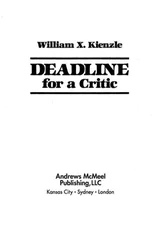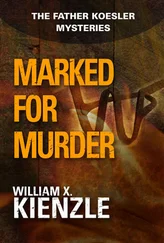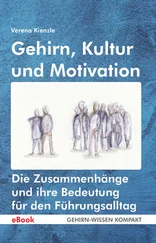“Now, I believe that his anonymous conspirator, while he shares Whitaker’s objective—to draw the media into the affairs of this hospital—had a somewhat different reason for wanting all this exposure.
“Four people here very much wanted Sister Eileen out of the picture. Two of them, Dr. Lee Kim and Ethel Laidlaw, a nurse’s aide, face imminent dismissal. The other two, Sister Rosamunda and John Haroldson, face a forced and most distasteful retirement.
“If Sister Eileen were to be removed from St. Vincent’s, the worries of each of these four people would be over. There are a couple of ways that could happen.
“Sister Eileen might die. She might, indeed, be murdered. That would be the simplest, most direct way of getting her off the scene.
“Or in a slightly more circuitous way, she could be removed from her position here. And that could be accomplished in one of two ways. Her religious order could do it. But, in fact, her order had consistently backed and supported her.
“Or the archbishop could depose her. And if enough pressure were exerted, the archbishop might have no other choice.
“So you see, I think we are not necessarily looking for someone who wanted to murder Sister Eileen,” Koesler nodded to Lieutenant Harris, “but, I think, we are very definitely looking for someone who needed to have her removed from office. The person who has been repairing Bruce Whitaker’s blunders is in accord with Whitaker’s objective, although not for Whitaker’s reasons.
“There is also one more outstanding area of agreement between the two: the method of operation.
“As I said before, there were a couple of ways of getting rid of Sister Eileen. The most direct was murder. Many people have been murdered with far less motivation than that held by the four people I’ve mentioned.
“The other way was the extremely circuitous method used by Whitaker . . . whose chief goal was not to get rid of Sister Eileen, but to force the archdiocese to act on what he saw as evil.
“As soon as Lieutenant Harris reminded me that in the operating room no one was trying to kill Sister, it dawned on me that we were looking for someone who, far more than being in agreement with Whitaker’s objective, was as one with Whitaker’s method of operation.
“Whitaker did not want to kill anyone. He kept doing things that would have multiple effects. He wanted to mutilate IUDs, he planned on making a sick person a little more ill, he plotted to close down an essential hospital function. Each of these plans was intended to have a side effect: the creation of a media event for the purpose of getting St. Vincent’s in alignment with official Church teaching.
“Well, not too long ago I had lunch here with a gentleman who was actually lecturing me about the same sort of philosophy. He even corrected me when I referred to the method as the principle of double effect, which is its more popular identification. He insisted on calling it the principle of the indirect voluntary, which is more technically correct.
“This person, John Haroldson, was extremely comfortable with the indirect voluntary. For instance: A surgeon operates, a good or indifferent action; the first effect—and the one desired—is the health of the patient; a secondary, only tolerated, effect is the removal of an ectopic pregnancy.
“Or one alters a patient’s chart, perhaps an indifferent action; the desired effect is that this will draw in the media who will be instrumental in returning the hospital to orthodoxy as well as removing Sister Eileen from the scene; the only tolerated effect is that the sick person becomes a little more ill before an intervention is made and the patient is saved.
“Although Mr. Whitaker would seem to be a very traditional Catholic, he probably would be hard pressed to explain either the indirect voluntary or the double effect. But, as it happens, what he was trying to do very closely resembled the indirect voluntary.
“Someone like John Haroldson would easily recognize the comparison. It was natural that the scheme would appeal to him. And very understandable that, to accomplish his own goal of ridding himself of Sister Eileen, he would find Whitaker’s scheme particularly appropriate.
“Now, the special problem that presents itself is, as Inspector Koznicki has mentioned, that the whole scheme has not worked. Because of John Haroldson’s expertise, both as theologian and medical student, the media event did occur. But, to date, no one has been able to take Mr. Whitaker seriously. After all this, the plan has failed. And, as far as Mr. Haroldson is concerned, it matters little that St. Vincent’s is still doing business as usual. What matters to him most is that Sister Eileen is still in place as CEO.
“Haroldson’s tenure here at St. Vincent’s grows shorter and more tenuous by the day. But I think that is less significant to him than the frustration he must feel now that what must have been his last-ditch plan to unseat Sister Eileen is in shambles. I’m just afraid that now he may be tempted to do something . . . uh . . . drastic.”
Koesler halted. There was nothing more to say. He had presented his theory, explained it, and drawn his conclusion. Either these officers would, in the face of his previous blunder, stretch credulity and believe him, or they would not. He looked about. The expressions reflected everything from the friendly faith of Inspector Koznicki to the hostile skepticism of Lieutenant Harris, and all points between.
“I think,” Koznicki said at length, “that in view of what Father has expressed, and as a matter of precaution—”
He was interrupted by a series of hysterical shrieks coming from nearby.
Led by Koznicki and Harris, Koesler and the officers rushed from the room in search of the source of the sound. The screams were coming not from the adjoining office but from the one adjoining that.
It was Sister Eileen’s office. It was her secretary, Dolly, who was screaming.
Koznicki, unexpectedly agile for his size, was first to enter Sister’s office. He saw Dolly standing near the large executive desk. At sight of him, she ceased screaming, but stood badly trembling.
Koznicki followed her riveted gaze to the knees and feet of a prostrate figure half hidden by the desk. It was a nun; he could see the white habit extending to sensible black shoes.
As one of the officers steadied Dolly, Koznicki crossed behind the desk and knelt beside the still figure of Sister Rosamunda. Father Koesler eased his way through the now crowded office and knelt on the other side of Sister’s body.
Koznicki felt for an artery in Sister’s neck. There was no pulse. He shook his head. A small bottle lay on the floor a few inches from Sister’s outstretched hand. It was empty, or nearly so. Only a few drops remained.
Koznicki read the label: “Elixir Terpin Hydrate.” He sniffed at the bottle. “Nothing I can identify. But poison, I assume.” He looked intently at Dolly and by sheer force of his will drew her gaze. “These questions are important, so please compose yourself.” He waited a moment until he could tell that she was in greater control of herself. “All right. Now, where is Sister Eileen?”
“In there.” Dolly pointed to the rear door that led to Eileen’s living-and-bedroom suite.
Koznicki jerked his head toward the door. Instantly, Lieutenant Harris entered the inner suite after a perfunctory knock on the door.
“Why is Sister Eileen back in her suite so soon after major surgery?” Koznicki asked.
“She was doing so well,” Dolly explained in a low tone. Though she seemed composed, the tremolo in her voice betrayed her continuing anxiety. “Of course she was taken to ICU after her operation. But she recovered remarkably well. And she asked . . . well, she demanded to be returned to her own room instead of one of the regular hospital rooms. And she is CEO, you know . . . .”
Читать дальше












